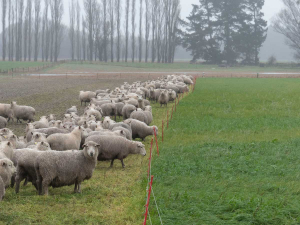Waikato sharemilker launches ‘Tinder for cows’ using AI and breeding data
Waikato sharemilker Matthew Zonderop had no inkling that one day he would become a matchmaker for cows.
 When considering to breed their hoggets farmers need to consider what the likely feed availability is going to be on their farm in winter.
When considering to breed their hoggets farmers need to consider what the likely feed availability is going to be on their farm in winter.
While breeding hoggets can potentially increase the number of lambs weaned and income – it needs to be well managed to be successful.
Breeding of hoggets for many farmers will begin in late April early May. Now is the time to consider which and how many hoggets to breed. There are two basic rules.
Firstly, they need to be at least 65% of their mature weight, which is basically their four-tooth breeding weight – if high levels of performance are to be achieved as a hogget and lifetime performance not negatively affected. An alternative means of identifying suitable hoggets is only breeding those with a body condition score of 2.5 or above.
Secondly, farmers need to consider what the likely feed availability is going to be on their farm in winter. That’s about accessing covers now, in some regions these may be low due to dry conditions and trying their best to predict covers in the winter. Remember the pregnant hogget is a class of stock that needs to be well fed throughout winter.
Although the temptation may be there to breed many hoggets this year, with the aim of obtaining high lamb prices. However, farmers – in general – should be conservative when deciding how many hoggets should be bred, especially if covers are low.
Using vasectomised rams (teasers) can increase the proportion of hoggets bred and those bred early in the breeding period. Teasers should be introduced 17 days prior to the first day of breeding. A minimum ratio of 1:100 is required to be fully effective. Hoggets are shy breeders therefore, an ideal ram to hogget ratio is 1:50 with mature rams. Use rams that are not likely to result in large lambs, which would increase the risk of birthing difficulties. Hoggets should be vaccinated to provide protection against abortive diseases.
When planning feeding levels for hoggets remember they need to be gaining approximately 130g/day throughout pregnancy to ensure they continue to grow and to meet pregnancy requirements. Failure to achieve this will result in disappointing results this spring and at the following two-tooth breeding.
The Massey University team, with funding from B+LNZ are currently examining the potential impacts of selecting progeny born from hoggets as replacement ewes.
• Paul Kenyon is a professor in sheep husbandry and deputy head of the agriculture & environment school at Massey University
Canterbury farmer Michelle Pye has been elected to Fonterra’s board for a three-year term.
Farmers are welcoming the announcement of two new bills to replace the under-fire Resource Management Act.
The Government has announced it will immediately roll over all resource consents for two years, with legislation expected to pass under urgency as early as this week.
The New Zealand National Fieldays Society has achieved a major sustainability milestone - reducing its greenhouse gas emissions and reaching the target five years early.
Fonterra's 2025/26 financial year is off to a strong start, with a first quarter group profit after tax of $278 million- up $15m on the previous year.
Government plans to get rid of regional councillors shows a lack of understanding of the fundamental problem affecting all of local government - poor governance.

OPINION: Your old mate welcomes the proposed changes to local government but notes it drew responses that ranged from the reasonable…
OPINION: A press release from the oxygen thieves running the hot air symposium on climate change, known as COP30, grabbed your…